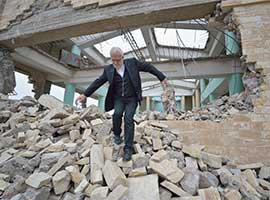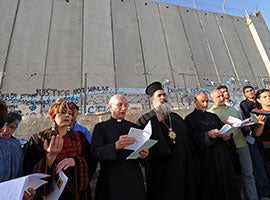Policy & Advocacy
Who are the Catholics of the Middle East?
GET INVOLVED
Read the bishops' statement on how our nation can take action in the Middle East
Learn more about the Syrian refugee crisis
Pray for peace in the Middle East
Sign up to be part of our advocacy network and let our elected leaders hear the voice of the Catholic community!
Visit To Go Forth, the blog by the Department of Justice, Peace & Human Development!
Seven Catholic Churches or "Rites," each bearing a great and ancient history with unique liturgical traditions and culture, comprise the Catholic Church in the Middle East. Each of these Catholic Churches is in full communion with Rome, but six Eastern Rite Churches are sui iuris, or self-governing, and have their own Patriarchs. All these Churches are immersed in Arabic culture and speak the vernacular Arabic, although the Syriac Catholic liturgy is also conducted in Aramaic.
The Maronite Catholic Church is the largest of the Eastern Catholic Churches in the Middle East at around 1.7 million members. It has a strong presence in Lebanon, with smaller communities in Syria, Jordan, Cyprus, and the Holy Land. However, slightly over half its members have emigrated from the Middle East to countries such as Argentina, Brazil, Australia, Mexico, Canada, and the U.S. The Maronite Church traces back to a community formed around St. Maron, a 4th century monk who led an ascetic life. They were staunch defenders of the decrees of the Council of Chalcedon and thus received papal recognition in 518 A.D. There is a strong tradition among the Maronites that their church never lacked communion with the Holy See since its formation in the 4th century. The Patriarch of Antioch of the Maronites resides in Bkerke, Lebanon.
The Melkite Greek Catholic Church is the next largest Eastern Catholic Church in the region, at 1.5 million members, of which over 700,000 reside in the Middle East, principally in Lebanon and Syria, but also in Jordan, Israel, Egypt and the Sudan, with a small number in Iraq. As with the Maronites, about half of its members have emigrated, moving especially to Brazil and Argentina, but also to Australia, Canada, the U.S., Venezuela and Mexico. The Melkite Church was formed in 1729 in Syria after a group separated from the Greek Orthodox Church to be in union with the Holy See. The Patriarch of Antioch of the Greek Melkites resides in Damascus, Syria.
The Armenian Catholic Church has over 700,000 members, less than one tenth of whom reside in the Middle East and the remainder spread across Europe, North America, Latin America and Australia. The largest concentrations of Armenian Catholics within the Middle East are found in Lebanon and Syria but there are also dioceses in Iraq, Iran, Egypt, Turkey, and Israel. Until the 18th century, Armenian Catholics were under the authority of the Armenian Orthodox Patriarchate of Constantinople. Needing their own spiritual leader, the Armenian Catholic bishops in 1742, after petitioning Rome, elected their first Patriarch, who chose as his patriarchal seat the monastery at Bzommar, Lebanon. After a brief relocation to Constantinople, the Patriarch of Cilicia of Armenian Catholics returned his seat to Bzommar, with his residence and offices in Beirut, Lebanon. Visit www.armeniancatholic.org/ for more information.
The Chaldean Catholic Church has over 600,000 members, with about 45 percent residing in the Middle East. The Chaldeans are historically concentrated in Iraq as they came from the Assyrian Church of the East. In 1552, a group of Assyrian bishops decided to seek union with Rome. Although Pope Julius III proclaimed Patriarch Simon VIII Patriarch "of the Chaldeans," pro- and anti-Catholic parties struggled within the Assyrian Church of the East until 1830, when another Chaldean Patriarch was appointed. The Patriarch of Babylon of the Chaldeans sits in Baghdad, Iraq; Chaldeans comprise about two-thirds of Iraqi Christians. This Catholic Church is under particular stress due to the war in Iraq, and many Chaldeans have fled to escape the violence. Chaldeans can also be found in Iran, other Middle Eastern countries, Australia and the U.S. Visit https://saint-adday.com/ for more information
The Coptic Catholic Church's almost 164,000 members are in Egypt, particularly in Upper Egypt. In the 18th century, a Coptic Orthodox bishop became Catholic and the Pope appointed him Vicar Apostolic of the small community of Egyptian Coptic Catholics, which at that time numbered no more than 2,000. Since 1947 the office of Patriarch has been filled. The Patriarch of Alexandria of the Copts is located in Cairo, Egypt. For more information regarding the Coptic Catholic Church, please reference The Eastern Catholic Churches – A Brief Survey (7th ed.).
The Syrian Catholic Church is spread throughout much of the Middle East, but roughly 130,000 of its 200,000 members are in Syria, Iraq, and Lebanon. An increasing number are in the United States or Venezuela. The 17th through 18th centuries saw an increase in Syrian Catholics, and in 1729 the first in a long chain of Syrian Catholic Patriarchs was elected. The Patriarchate moved several times before settling in Beirut, Lebanon. For more information regarding the Syrian Catholic Church, please reference The Eastern Catholic Churches – A Brief Survey (7th ed.)
The Roman Catholic Church (Latin Rite) remains a substantial presence in the Middle East with nearly 2.7 million members, more than any other Catholic Church. However, almost 2.5 million of these Latin Catholics are migrant workers who come from countries like the Philippines, India, and Ethiopia to work mainly in the Arabian Peninsula and Kuwait. Of the remaining 200,000, the Latin Patriarchate of Jerusalem comprises the largest number of Latin Catholics at about 160,000. These Roman Catholic jurisdictions are not sui iuris like the Eastern Catholic Churches, but function like other dioceses of the Latin Rite.


